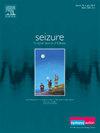儿童顽固性癫痫与结节性硬化症相关:诊断和治疗的回顾性队列研究
IF 2.8
3区 医学
Q2 CLINICAL NEUROLOGY
引用次数: 0
摘要
背景:结节性硬化症(TSC)患者常并发难治性癫痫(RE)。本研究评估了与TSC相关的多种危险因素,以确定RE的危险因素。方法入组后,将315例TSC相关癫痫患儿分为对照组和RE组。多模式数据用于表征RE的危险因素,包括临床数据、抗癫痫药物(ASM)或西罗莫司的使用、家族史、基因型、癫痫发作类型、神经影像学和脑电图结果以及发育评估。结果婴儿痉挛、痉挛发作次数、丛集性发作、家族史、TSC2突变、II型及Ⅲ病变与RE呈正相关。MRI结果显示,在预测RE方面,病变类型比病变大小和位置更重要。对照组和RE组在痉挛、运动发育延迟或认知延迟方面存在显著差异。丙戊酸是最常见的ASM,其次是维加巴林和奥卡西平。II型病变的存在使RE的风险增加了1.63倍。结论起病时间、婴儿期痉挛、II型病变、TSC2突变状态、家族史和聚集性癫痫发作是发生RE的潜在危险因素,即使有亚临床癫痫样脑电图放电,也应建议对TSC患者进行ASM治疗。儿童早期使用维加他林和西罗莫司可减少RE的发生。本文章由计算机程序翻译,如有差异,请以英文原文为准。
Pediatric refractory epilepsy related to tuberous sclerosis complex: A retrospective-cohort study of diagnosis and treatment
Background
Tuberous sclerosis complex (TSC) patients often develop refractory epilepsy (RE). The present study evaluated numerous risk factors associated with TSC to determine risk factors of RE.
Methods
After enrollment, 315 pediatric patients with TSC-associated epilepsy were divided into control and RE groups. Multimodal data were used to characterize risk factors for RE, including clinical data, anti-seizure medication (ASM) or sirolimus use, family history, genotype, seizure types, neuroimaging and EEG findings, and developmental assessments.
Results
Infantile spasms, number of ASMs being taken, clustered seizures, family history, TSC2 mutation, and presence of type II and Ⅲ lesions were positively correlated with RE. Age of onset, age of first hospital visit, and use of vigabatrin were negatively correlated with RE. MRI findings suggest lesion type is more important than lesion size and location in predicting RE. There were significant differences in spasms and delayed motor development or cognitive delay between the control and RE groups. Valproate was the most common ASM used, followed by vigabatrin and oxcarbazepine. Risk of RE was increased as much as 1.63-fold by the presence of type II lesions.
Conclusions
Age of onset, infantile spasms, type II lesions, TSC2 mutation status, family history, and clustered seizures were identified as potential risk factors for the development of RE. ASM should be recommended for TSC patients even in cases with subclinical epileptiform EEG discharge. Using vigabatrin and sirolimus earlier in childhood may reduce the occurrence of RE.
求助全文
通过发布文献求助,成功后即可免费获取论文全文。
去求助
来源期刊

Seizure-European Journal of Epilepsy
医学-临床神经学
CiteScore
5.60
自引率
6.70%
发文量
231
审稿时长
34 days
期刊介绍:
Seizure - European Journal of Epilepsy is an international journal owned by Epilepsy Action (the largest member led epilepsy organisation in the UK). It provides a forum for papers on all topics related to epilepsy and seizure disorders.
 求助内容:
求助内容: 应助结果提醒方式:
应助结果提醒方式:


